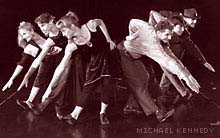The Fractured 21st Century: Zenon at Illusion.
Camille LeFevre had mixed feelings about the Zenon Dance performance at the Illusion Theater: is it art even when you're not sure what it is? But skill and athleticism, wit and the desire to entertain, carry the day.

The fractured storytelling of postmodern dance (or is it post-post-modern by now?) tends to juxtapose fragments of character, movement, and emotion to emphasize the harried pace and superficial attentions of 21st-century life. Zenon’s 22nd spring concert presents new works by Jeanine Durning and Bill Young, both of New York City; the frenetic, edgy tone of these dances fits this description.
Both Durning’s “Inter Ruption” and Young’s “Wildlife / Shades of Rose” are non-narrative, full-company works packed with shards of zany characters, odd interactions, vocal outbursts, awkward poses, and blink-and-you’ll-miss-it movements. These bits and pieces rub up against each another, producing emotional friction, goofy humor, and some amazing moments of unexpected choreography. The dancers inhabit and convey their characters’ disjunctive idiosyncrasies with clarity; and they zip with physical stamina and technical fluidity from one scenario to the next.
Durning’s “Inter Ruption” features a jazz score written and performed live last Friday night by New York saxophonist Ted Nash, with additional instrumentation by the Minneapolis-based Jazz is NOW! Ensemble. The musicians sit in chairs, and stroll about on stage, as the dancers cavort around them in goofy costumes, feathers and tulle poking out of their sleeves, hats, and vests.
They swing their arms and sway their bodies to the rhythms of the score, sprinkling unexpected flecks of musicality into the choreography. They ebb as a group to one side of the stage, and Greg Waletski jumps up and down with arms akimbo as cymbals crash. Then the dancers strip off their outer gear to reveal more svelte costumes, and Tamara Ober starts ordering them around. “Not there!” she shouts as the dancers change arm and leg positions to meet her approval.
The mood continues to become more confrontational. Amy Behm and Devin Carey slap each other’s hands away, an interaction repeated later by other dancers. Ober slams into Stephen Schroeder and sends him sprawling. Christine Maginnis crawls across the floor following an invisible something Behm rubs in her hand.
The women stand over the prone men, while Schroeder puts his face up close to an increasingly squeamish Carey. The dancers pump their arms, fling their hands, extend their legs in jumping arabesques. They curve into each others’ angular embraces. And they express their annoyance, discomfort and satisfaction with increasing animation.
Young’s “Wildlife/Shades of Rose,” featuring an original score by Mio Morales, feels lighter, more childlike– in fact, like kids on a playground. The work opens with a tantrum of sorts. Behm, lying on the stage, arches her back and slams it into the floor with dispassionate zeal.
The dancers are all wearing tennies, skirts or pants, and t-shirts or sweatshirts. Their attention spans are short. Girls kiss girls, then boys. Glimpses of schoolyard games— duck-duck goose, crack-the-whip, blanket toss (without the blanket)—are juxtaposed with lifts, clutches and twirls. One performer tells a story, another sings “La Vie En Rose.” Others bite, cough, bark, growl, or trill. They’re roughhousing and you want to yell out in motherly warning, “Someone’s going to get hurt!” But they don’t. Instead, their interactions often end up as strange and unusual movements.
In their sheer quirkiness, these pieces are entertaining. They’re also, at times, a tad annoying: a formalist soul like mine cries out for a flash of beauty, my heart for a reason to care, my mind for a narrative thread (however transparent) to hang all of this detritus onto. But in their works, Durning and Young provide a window into an artistic sensibility quite unlike anything in Minnesota. As always, that’s refreshing.
At either end of the program are two completely different dance pieces—one an abstract modern work, the other a giddy burlesque—demonstrating, as Zenon always does, the remarkable adaptability, dexterity, and physicality of its dancers. The program opens with Wil Swanson’s linear, shadowy “Lost Things.” A Duluth native, and former company member of Minneapolis’s New Dance Ensemble and New York’s Trish Brown Dance Company, Swanson’s works are often a blend of downtown daring and rigorous formalism. This piece still needs to find its footing.
Swanson set his meditative piece to operatic music by Michael Gordon, David Lang, and Julia Wolf. (Where have I heard this score before? In Cynthia Stevens’ work? It’s an incantation on loss.) The dancers are spread out on stage, the choreography dispersed, airy, but limpid. It includes soft turns, little hops and stumbles, lines of dancers that slowly fall like dominos, and crumpled bodies on the floor. The work has a lovely quality, but seems unfinished and without a clear intent.
Conversely, the program ends with the reprise of “No Turn On/Red,” by Myron Johnson, artistic director of Ballet of the Dolls. It’s an exuberant stage show—think disco meets flamenco (briefly) meets Chippendale meets ballet—with wild music a la Bond. Dressed in lingerie-like black and red costumes, the dancers kick and whirl with aerobic zest. They’re on a mission—to entertain. And they don’t disappoint.
Zenon performs 8 p.m. Friday–Saturday, 7 p.m. Sunday, at
Illusion Theater, Hennepin Center for the Arts, 528 Hennepin Avenue, Minneapolis. $21. Call 612-339-4944.